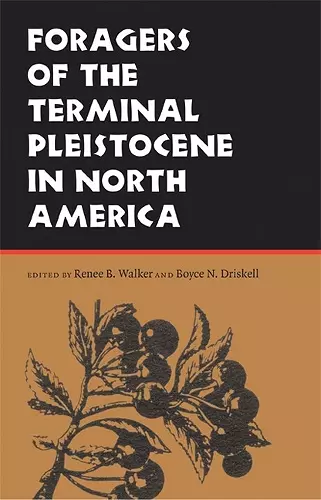Foragers of the Terminal Pleistocene in North America
Boyce N Driskell editor Renee B Walker editor
Format:Paperback
Publisher:University of Nebraska Press
Published:1st Jan '10
Currently unavailable, and unfortunately no date known when it will be back

A collection of the best current archaeological studies of Paleoindians shedding new light on the first humans to arrive in North America
Written in an accessible, engaging style, these essays examine how migratory waterfowl routes may represent one impetus for human migration into the Americas, analyse settlement and subsistence in the major regions of the United States, and reinvestigate mammoth and bison bone beds in the western Plains and the Rocky Mountains to illuminate the unique nature of Paleoindian hunting in that region.These essays cast new light on Paleoindians, the first settlers of North America. Recent research strongly suggests that big-game hunting was but one of the subsistence strategies the first humans in the New World employed and that they also relied on foraging and fishing. Written in an accessible, engaging style, these essays examine how migratory waterfowl routes may represent one impetus for human migration into the Americas, analyze settlement and subsistence in the major regions of the United States, and reinvestigate mammoth and bison bone beds in the western Plains and the Rocky Mountains to illuminate the unique nature of Paleoindian hunting in that region. The first study of Paleoindian subsistence on a continental scale, this collection posits regional models of subsistence and mobility that take into account the constraints and opportunities for resource exploitation within each region: Research on the Gault site in Texas reveals new subsistence strategies there, while data from the Shawnee-Minisink site in Pennsylvania connects seed collecting with fishing in that region, and plant remains from Dust Cave in Alabama provide important information about subsistence. With research ranging from fauna and lithic data from Paleoindian campsites in Florida that illuminate subsistence technologies and late megamammals to an analysis of plant remains from the eastern United States that results in a revised scheme of environmental changes, this volume serves as an important sourcebook and guide to the latest research on the first humans in North America.
"An important addition to the literature concerning Paleoindian subsistence and settlement patterns."—Journal of Middle Atlantic Archaeology
“Should be required reading for all those interested in Paleoindian adaptations.”—William R. Hildebrandt, Journal of Field Archaeology
ISBN: 9780803232860
Dimensions: unknown
Weight: unknown
344 pages